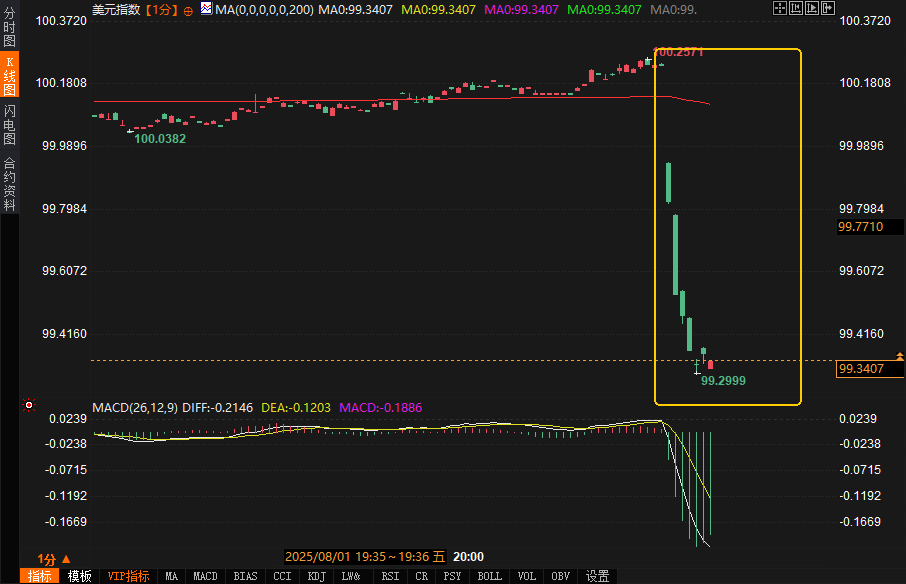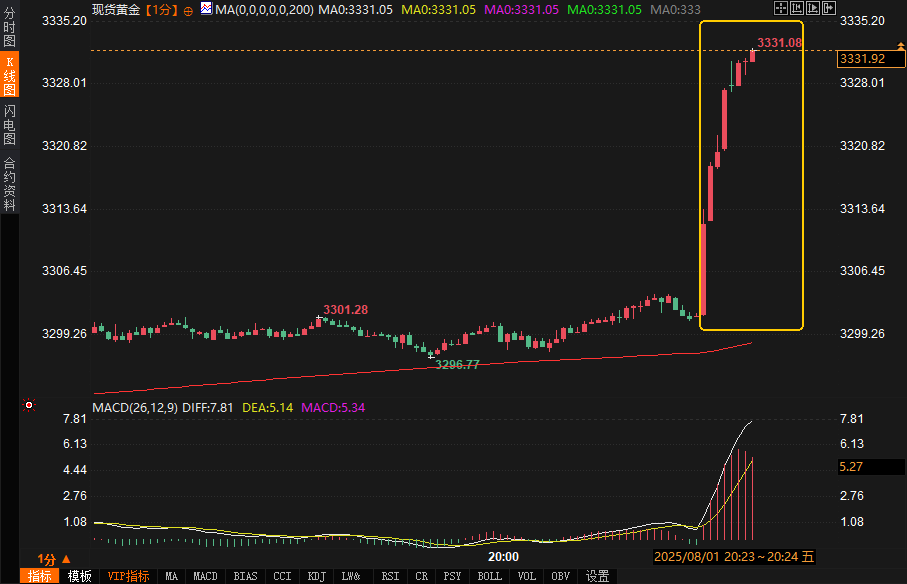The unexpected non-farm payroll report triggered an epic charge for gold, and the US dollar bulls were severely besieged and plummeted by more than 100 points!
2025-08-01 20:48:54

Following the data release, the US dollar index plunged 105 points, hitting a low of 99.1899. Spot gold prices surged by approximately $34, reaching a high of $3,335.17 per ounce. Major currency pairs, such as the euro/dollar, also saw significant fluctuations. The following analysis focuses on the immediate market reaction, evolving expectations for rate cuts, and future market trends.
Immediate market reaction: US dollar plunges, gold soars, and bond markets tend to loosen
Financial markets reacted swiftly to the release of the non-farm payroll data, demonstrating a typical risk-off and easing expectations-driven market. The US dollar index plummeted sharply following the release, falling as much as 0.42% to a low of 99.1899, a new intraday low. In contrast, the euro rallied against the dollar, extending its intraday gains to 1.01% at 1.1527, breaking through the key 1.1500 level and reaching a two-session high. The dollar also came under pressure against the yen, falling 1.00% to 149.22, signaling a rapidly growing bearish sentiment towards the dollar. Retail traders generally believe the dollar may test support at 99.25 in the near term, with a break below potentially pushing it towards 98.50.

Meanwhile, the precious metals market emerged as the biggest winner following the data release. Spot gold surged from $3,301 to $3,330 within five minutes, reaching a high of $3,335.17, a 1.24% intraday gain and breaking through the key resistance level of $3,330. The main COMEX gold futures contract also rose 1.02% to $3,382.70. Institutional analysts note that gold bulls are rapidly targeting the $3,340-3,345 range. The hourly chart shows that the previous resistance level of $3,333.91 has been broken, indicating bullish short-term momentum. Retail traders generally believe that the gold rally was driven not only by the weak non-farm payroll data but also closely tied to the market's repricing of the Federal Reserve's easing policy. Spot silver also performed strongly, rising 0.41% to $36.833, a new intraday high. However, the platinum market showed mixed performance, with spot platinum falling 1.19% to $1,290.30 an ounce, while the main Nymex platinum futures contract rose slightly by 0.18% to $1,301.4 an ounce.

In the U.S. Treasury market, the 10-year Treasury yield fell 1.14% to 4.327%, while the 2-year Treasury yield fell 8 basis points to 3.871%. The 2/10-year yield curve steepened to 48.8 basis points. The decline in bond yields reflects growing market expectations of an economic slowdown and easing Federal Reserve policies. S&P 500 futures fell 0.8% following the data release, indicating that the stock market was under pressure from both weak jobs data and Trump's tariff rhetoric, further fueling risk aversion.
Expectations of rate cuts rekindled: Market sentiment shifts from hawkish to dovish
Before the release of July's non-farm payroll data, market expectations for the Federal Reserve's monetary policy had already shifted significantly toward a hawkish stance. Prior to this, Fed Chairman Powell's hawkish stance and the stronger-than-expected June inflation data had caused the market's probability of a 25 basis point rate cut in September to drop from 64.5% a week earlier to 43%. However, the 73,000 non-farm payroll increase, which fell far short of expectations, coupled with significant downward revisions to May and June data, rapidly intensified market bets on an easing Fed policy. Futures market data showed that traders' probability of a 25 basis point rate cut in September had jumped from 45% before the data to 75%, with the possibility of an October rate cut fully priced in. In contrast, the probability of a European Central Bank rate cut in March 2026 had also risen from 65% to 80%, indicating a synchronized shift toward easing in global monetary policy expectations.
This shift was further reinforced by institutional and retail interpretations. Following the release of the data, institutions commented that the non-farm payroll figures were "eye-popping," providing a strong rationale for a September rate cut by the Federal Reserve and predicting continued pressure on the US dollar index in the short term. Retail traders, however, noted that the optimal market scenario entailed a slight rise in the unemployment rate and slightly higher-than-expected job creation. However, the current figures were well below expectations, suggesting a weakening labor market but not yet triggering recession fears. This "soft landing" expectation fueled gains in gold and non-US dollar currencies, while simultaneously pushing down US Treasury yields.
However, the market isn't overwhelmingly bearish on the US economy. Jonathan Pingle, UBS's chief US economist, stated that while the 73,000 jobs gain fell short of expectations, the monthly job growth required to maintain a stable US labor market has fallen to approximately 86,000 due to factors such as reduced immigration, making the data not entirely weak. Guy Berger, a senior fellow at the Burning Glass Institute, a labor market think tank, further noted that most major indicators have remained stable since last fall, demonstrating the economy's resilience. This divergence is also evident in some retail investors' belief that the market's reaction to the data may be overly pessimistic, and that the US dollar index could trigger a technical rebound at support at 99.25.
Outlook for future trends: Short-term volatility intensifies, long-term focus on inflation and policy games
Looking ahead, the weak July non-farm payroll data has injected new uncertainty into the market, potentially exacerbating short-term volatility in financial asset prices. Gold's appeal as a safe-haven asset will continue to grow, especially after breaking through the 3333.91 resistance level. Bullish targets could target the 3340-3345 area, or even higher. However, caution is warranted regarding rapidly shifting market sentiment. If subsequent economic data (such as inflation or consumer confidence) show resilience, gold could face downward pressure. The US dollar index could continue to test the 99.25 support level. A failure to break above this level could open up downside potential to the 98.50 area. However, if the sell-off triggered by the jobs data is absorbed, the dollar could stabilize on technical buying support.
The short-term decline in US Treasury yields is likely to continue, with the 10-year yield, in particular, showing signs of weakness around 4.327%. However, in the long term, if inflationary pressures intensify due to tariff rhetoric or OPEC+ production increases, yields could resume their upward trend. In the stock market, the decline in S&P 500 futures reflects market concerns about an economic slowdown, but the risk of a correction in highly valued sectors such as technology stocks is particularly concerning. MarketWatch noted that the Dow Jones Industrial Average could face a 400-point drop, highlighting the market's high sensitivity to employment data and external uncertainties.
From a longer-term perspective, the Federal Reserve's policy path will be the core driver of market trends. Market expectations for rate cuts in September and October have already significantly increased, but the pace of rate cuts may slow if subsequent inflation data or employment indicators demonstrate economic resilience. Investors should closely monitor upcoming inflation data (such as CPI and PCE) as well as guidance from the Federal Reserve's September FOMC meeting to gauge the pace and intensity of policy easing. Furthermore, OPEC+'s planned production increase may exert some pressure on commodity prices, thereby impacting inflation expectations and the Fed's policy room.
The unexpectedly weak July non-farm payroll report shattered market expectations of a hawkish Federal Reserve policy. The US dollar index plunged, gold prices surged, and US Treasury yields retreated, signaling a rapid shift in market sentiment toward dovishness. While institutional and retail investors alike interpreted the data as providing strong support for a September rate cut, differing views emerged regarding the economy's resilience and cracks. In the short term, gold and non-US dollar currencies are likely to continue benefiting from expectations of easing, while the US dollar and US stocks face downward pressure. Longer-term, inflation data and the Fed's policy maneuvering will be key to market trends. Investors should remain cautious in this increasingly volatile environment and prioritize risk management to navigate the challenges presented by multiple uncertainties.
- Risk Warning and Disclaimer
- The market involves risk, and trading may not be suitable for all investors. This article is for reference only and does not constitute personal investment advice, nor does it take into account certain users’ specific investment objectives, financial situation, or other needs. Any investment decisions made based on this information are at your own risk.





















